
Miss Huttlestone's GCSE English
Because a whole class of wonderful minds are better than just one!

AQA Power and Conflict Poetry – an example comparative paragraph
Morning all,
In today’s lesson I will give you lots of resources to aid your comparison of two poems in the cluster. For today I have penned an example comparative paragraph on how POWER is depicted in ‘Ozymandias’ and ‘My Last Duchess’. The first two sentences acts as my introduction and ‘concept’ (the BIG IDEA) that all of my paragraphs should refer back to:
Both ‘Ozymandias’’ and ‘My Last Duchess’ depict power as being abused by oppressive figures and therefore as being closely aligned with corruption.
Primarily, In ‘Ozymandias’, Shelley presents power in two different ways: firstly, through how a corrupted leader abuses his power and secondly through how power ultimately won’t last and is transient compared to nature. Shelley illustrates the message that powerful leaders can be arrogant when Ozymandias calls himself the “king of kings”. Here Shelley’s use of plosive alliteration for the sharp “k” sound deliberately reflects the overbearing and oppressive power that Ramesses II had over his people when he became a pharaoh at young age. This phrase is poignant in stressing how arrogant and confident the speaker is about his power because he is stating that he is superior to any other ruler. Further to this, the noun “king” carries regal connotations to demonstrate that people in power like Ozymandias may often believe that they are higher to others. The fact that Ozymandias calls himself a king stresses how much the power has dominated his mentality and his thoughts. Similarly, in ‘My Last Duchess’, it focuses on how a Duke, a powerful figure within the social hierarchy, uses his power to control his duchess and thus how he lets power make him arrogant and possessive. Significantly, there is a sense of arrogance attached to power through Browning’s use of possessive pronouns such as “that’s my last duchess hanging on the wall”. Here however, we see how the Duke has let his power over women absorb him and he has become deluded into thinking that he still has power over his dead duchess. The use of the demonstrative “that” is repeated throughout the poem to add to his aggressive and mocking tone whilst showing that he sees his previous wife as an object or possession to him. Browning could be reflecting the conservative attitudes towards women at that time where women were submissive and subservient to their male counterparts and husbands. This arrogance is further shown when the Duke exclaims that he made the curtain and that he had “drawn it for you”. The way Shelley uses the pronoun “you”, when addressing the envoy, reveals how the Duke is deluded enough to think that he has absolute control over who interacts with his late wife. It’s almost as if the Duke finds it thrilling to restrict who can see her because now she has died he is able to have as much control over her than when she was dead.
Red = my perceptive and clear POINT
Green = my carefully integrated evidence
Blue = zooming in on evidence and analysis
Pink = context integrated where appropriate.

More example comparative paragraphs to follow! Please feel free to add your own in the comments for me to check.
Share this:
Published by.
gcseenglishwithmisshuttlestone
Secondary English teacher in Herts. View all posts by gcseenglishwithmisshuttlestone
Leave a comment Cancel reply

- Already have a WordPress.com account? Log in now.
- Subscribe Subscribed
- Copy shortlink
- Report this content
- View post in Reader
- Manage subscriptions
- Collapse this bar

Exemplar AQA Power And Conflict Essays
Model power and conflict essay - aqa june 2017 english literature exam - 'bayonet charge' and 'remains', model power and conflict essay - aqa june 2018 english literature exam - 'ozymandias' and 'tissue', model power and conflict essay - aqa june 2019 english literature exam - ' war photographer ' and 'remains', model power and conflict essay - aqa november 2020 english literature exam - ' war photographer ' and 'remains', exemplar english literature essays, aqa power and conflict poems - analysed in detail.
Comparing Poems
After studying this section you should be able to understand:
- what features to look for in each poem
- how to plan and write your response
As part of the GCSE English Literature course, one of the things you will need to do is to ‘explore relationships and comparisons between text, selecting and evaluating relevant material ’. One of the ways in which you might be asked to do this is to compare two poems.
When comparing poems you need to look for all the features that you look for when studying a single poem.
You need to look at the:
- content of the poem
- tone and mood of the poem
- form in which it is written and structured
- ways in which language is used
When writing your response, avoid writing an examination of one poem and then the other and comparing them in a final paragraph. Integrate your comments on the poems throughout.
However, you also need to compare these features in both poems.
You will need to look at each poem individually to plan your response, but when writing your response you need to integrate your ideas on both poems.
Watch the video below to help you understand key poetic terms and the forms and structure of poetry to help you analyse and compare poems for your unseen poetry paper.
Here’s one way you could approach this task:
Planning your response
1. Read both poems through carefully and get an overall sense of what each poem is about and how the poets handle their topics.
2. Re-read poem ‘A’ and make brief notes either around the poem, if you are able, or on a separate sheet, noting key words, phrases, images etc. and your response to it. Do the same with poem ‘B’.
3. Note down some brief quotations from each poem that you will use to illustrate your ideas. You could underline or circle these if you can write on the copy of the poem.
4. Make two lists – one headed similarities and one headed differences and list the main points under each heading.
Writing the response
It is important that you avoid writing an essay on each poem and then try to join them together. The best responses are those that integrate the ideas in parallel throughout the essay.
Here’s one way you could approach this:
INTRODUCTION
Introductory paragraph commenting on what each poem is about and capturing the ‘flavour’ of each.
Several paragraphs based on your detailed reading of the poems. It is a good idea to make a point about poem ‘A’ and then a point about poem ‘B’.
It can help you structure your ideas in a logical way, e.g. one paragraph could compare the way each uses imagery , while another paragraph could focus on structure etc.
A concluding paragraph, summing up the main similarities and differences, saying which you find more effective and why, if you are asked this .
Keep both poems at the centre of your focus and don’t be tempted to write all about one and then the other.


Anthony Cockerill
| Writing | The written word | Teaching English |
Teach your students how to compare poems for GCSE English Literature, Paper 2, Section B
Learn some of these brilliant strategies for teaching really effective poetry comparison for GCSE English Literature, Paper 2, Section B.
One of the elements of our students’ exam performance we identified as a weakness in last summer’s examination series was comparing poems from the AQA poetry anthology, Poems Past and Present, which forms part of GCSE English Literature Paper Two. In the English Department at Boroughbridge High School, where we teach the Power and Conflict cluster, we’ve been spending time over these past few weeks taking a closer look at what our students need to do in order to write a great poetry comparison. Using our current students’ work alongside papers we recalled from last summer – plus the ever helpful examiner’s report – we’re working to establish some maxims for how we teach this particular aspect of the examination, which I’d like to share with you in this blog post.
1. Get your students to know the poems really well.
‘Students who knew the text were able to move around and within it in order to respond to the specifics of the task.’ AQA Examiners’ report, June 2017.
There are some great ways to introduce students to poems, such as D irected A ctivities R elated to T exts, in which a student is usually instructed to reconstruct or resequence a text. An activity might encourage students to think about the form of the text, the structure, or the recurrence of particular types of language.

As a first encounter with Seamus Heaney’s ‘Storm on the Island’, students might consider what the poem could be about by exploring the nouns. Are there any patterns? Could they be classified into lexical fields? Or they might attempt to write a poem or description using words sorted by their function. Alternatively, a teacher might encourage students to engage intellectually or emotionally with the poem by exploring a still image, a moving image clip or by sharing a story.
The subsequent process of the shared reading of the poem in its entirety and the ensuing discussion is a great opportunity to model the process of reading, understanding and thinking analytically. A series of prompts – or something akin to ‘Key Questions’ – can work as a framework for class discussion, enabling students to think, and ultimately write, about the poems and also to provide a ‘schema’ to help them build and consolidate their knowledge and understanding.

When helping students to deal with aspects of language and structure, a teacher might provide a tool to help students structure their thinking and note-making (the acronym FLIRTS, for example, which stands for F orm and Structure, L anguage and Sounds, I magery, R hyme, Rhythm and Repetition, T heme and Tone, S peaker).
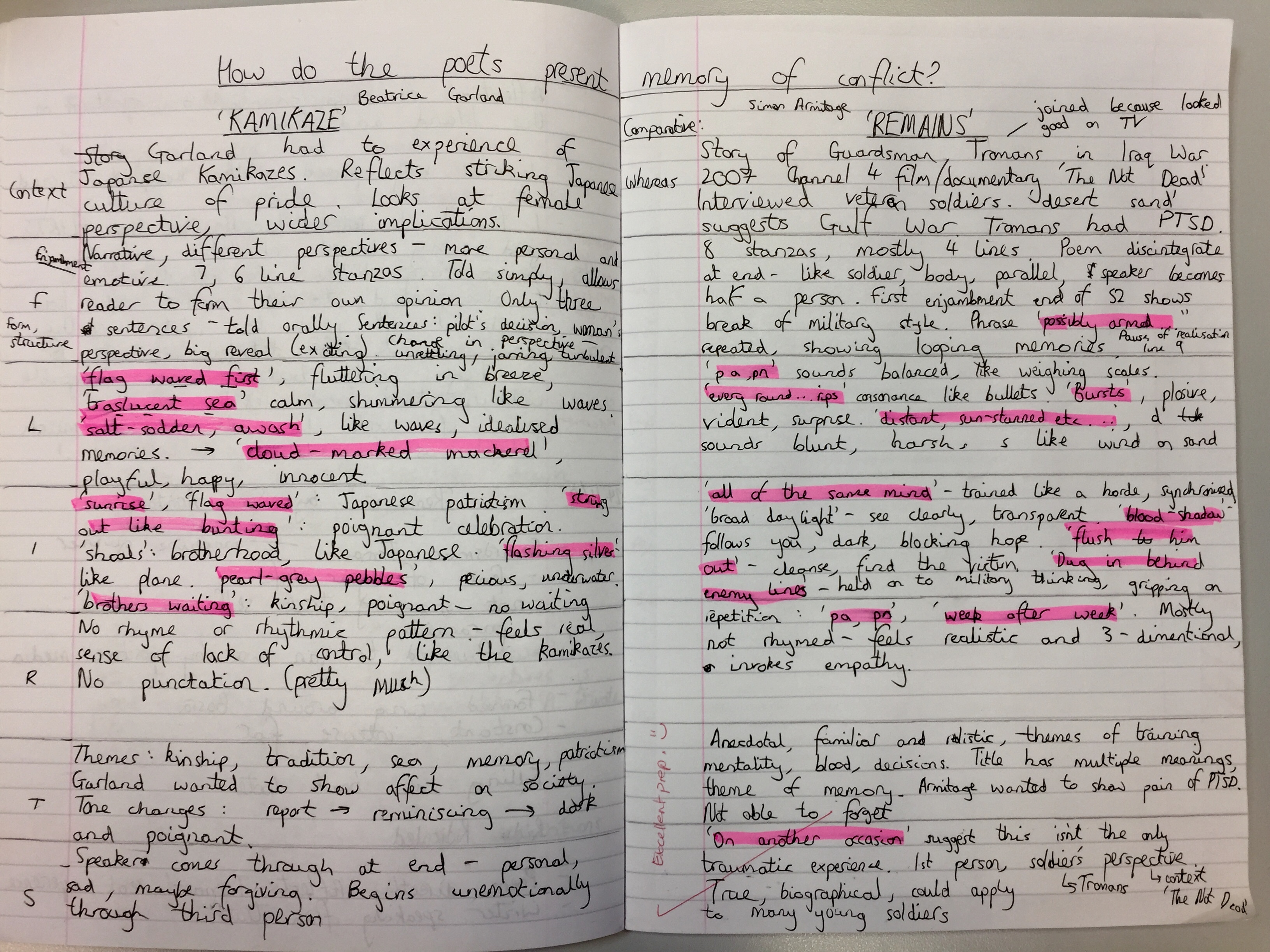
2. Cluster and study the poems thematically to help students to make a good choice of second poem.
‘The selection of the second poem is one of the keys to success as this gives the student the material to construct a holistic response.’ AQA Examiners’ report, June 2017.
The Power and Conflict cluster could be usefully divided into poems about power and legacy; poems about the power of natural world and conflict with humans; poems about conflict that can happen as a result of culture and belonging; poems about war and conflict. Thinking about the poems in these clusters will guide students toward making a helpful choice of second poem.
3. Don’t constrict written responses with a rigid framework, but instead provide more flexible ways of comparing the poems.
‘One examiner commented that one of their key teaching points for next year will be that “comparison comes in a variety of shapes and does not have to be formulaic”‘. AQA Examiners’ report, June 2017.
Some of the possible ways of structuring a poetry comparison can lead to answers which can constrain the level of the response. This can usually be evident when ‘essay plans’ are too simplistic (Poem A, then Poem B) or too artificial (Similarities and Differences) but also when they become too unwieldy. But the examiners’ report suggests that ‘…the key message here is to enable and guide students to form a comparison relative to their level of ability.’ In engaging with the poems, a student aiming for a top grade should aim for a conceptualised response which is exploratory in nature. A confident student might write an ambitious introduction which outlines their ‘angle’ on the question. They might seek an interesting angle on the task, such as how patriotism might lead soldiers into combat. Then they might develop their response along a series of conceptual lines of enquiry, integrating analysis of the writers’ methods as they go; illuminating their interpretation with contextual insight relevant to the task.
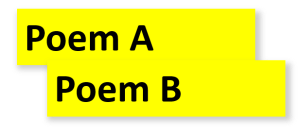
Rather than offering up a rigid ‘essay plan’, the ‘series of prompts’ I described above as a cognitive tool can function, when applied to both poems, as a sort of ‘loose structure’ to help students produce a more focused written response. I have found these ‘Key Questions’ to be useful in encouraging students to focus on a comparison of two poems. ‘What are the poems about?’ serves as an introduction to the whole response.

‘Who is ‘speaking’ in the poems?’, as I discuss in more detail below, allows the student to engage with the ‘constructed voice’ of the poem. ‘How has the poet used language and structure to convey their message?’ allows students to consider the writers’ methods. ‘Why have the poems been written?’ offers the opportunity to explore deeper layers of meaning, authorial intent and conceptual interpretations. However, it’s important to think of this approach as flexibly as possible. It wouldn’t be good, for example, to encourage students to think of the Key Question ‘why have the poems been written?’ as an opportunity to shoehorn context into their response. Ideas, exploration of the writers’ methods and apt integration of context should be evident throughout the response.
4. Think about the voice as a construct.
‘Students who recognised where the voice was a construct were more successful than those who regurgitated biographical information about the poet that they then attempted to link to the poetic voice.’ AQA Examiners’ report, June 2017.
Addressing the task itself – and considering why the poems might have been written – will enable the student to naturally explore context – rather than including lots of biographical information. But the ‘persona’ of the constructed voice might also provide a very useful way of considering context. In Simon Armitage’s ‘Remains’, for example, the narrative voice deftly reflects the turmoil of someone struggling to come to terms with what they’ve seen. Armitage’s narrator uses first-person plural pronouns, for example, to emphasise the narrator’s attempt to redistribute his own guilt among his comrades. Similarly in ‘Beatrice Garland’s ‘Kamikaze’, the modulating narrative perspective creates distance between the reader and the narrator that reflect the gulf between pilot and family. Context in this analysis, therefore, becomes implicitly connected to the student’s understanding of the task.
5. Make sure students understand the importance of answering the question.
When students start to write their responses – and if they’re using my ‘Key Questions’ approach, they’ll begin by considering what the poems are about – they must respond in terms of the question rather than with something generic. ‘Ozymandias’ by Percy Bysshe Shelley for example, explores the power of the natural world, but if the question is about the theme of mortality, then it is through this filter that the student must construct their response. It’s useful reiterate the key word from the question throughout throughout the answer to keep the response on track.
6. Get students to engage with the poem, rather than obsessing about poetry terminology.
‘Some responses set out to identify poetic techniques and employ as much terminology as possible before engaging with the poems themselves.’ AQA Examiners’ report, June 2017.
Sometimes, a student who is too heavy handed with various poetry terms can find themselves attributing questionable effects to the features they’ve ‘spotted’. It’s much better to encourage students to consider different layers of meaning in language and to consider possible interpretations.
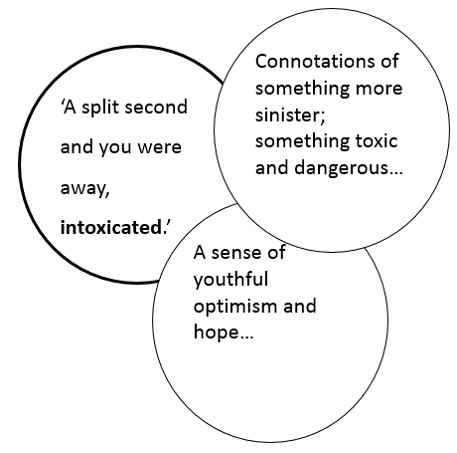
7. Flexible analytical writing is much more effective than the PEE paragraph.
‘The use of structures such as PEE / PEA and its variants worked in the sense that they allowed students working at the lower levels to access Level 3 in the mark scheme. However less rigid structures worked better for those working at higher levels.’ AQA Examiners’ report, June 2017.
As I have explained in an earlier blog post , I’m not sure I always taught analytical writing well earlier in my teaching career. For me, like many, the PEE paragraph was a formula to get students through coursework essays and to use as a model for exam-style responses.
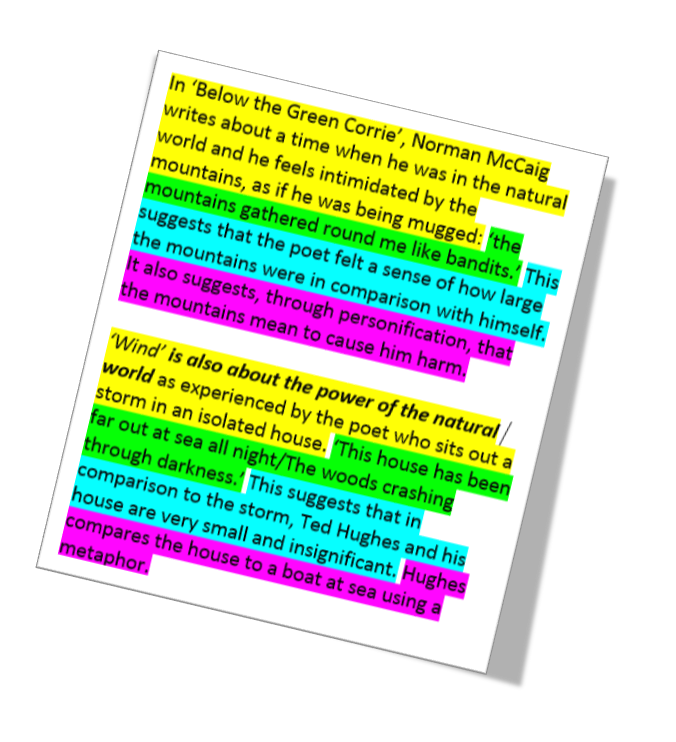
8. Teach students to integrate and embed short quotations – it’s much more effective than copying out longer quotations.

It’s much more productive when students embed judiciously chosen, short quotations into the essay, rather than wasting time copying out large chunks of text. The response will feel much more fluid.

9. Encourage students to write individual responses with precise, cogent expression and more sophisticated analytical writing techniques.
When aiming for top flight responses, there are several techniques students can deploy as part of a well-structured, insightful essay. These include evaluation, anticipating the response of the reader, tentativity, spotting patterns and deepening analysis are some great ways of making analytical writing more ambitious.

Here, the student has spotted patterns of language throughout the poem.
The student here has noted the ambiguity of the poem in this example of deepening analysis…
10. Familiarise students with how their work will be marked.
‘Mark schemes’ should be used with care, as the process of arriving at a level is a subjective judgement based around a guided standardisation process. Futhermore, the meta-language around each level needs to be properly exemplified and understood – something even experienced teachers and examiners need ongoing support with. This said, it is always a worthwhile exercise to share with students an exemplar script or two and a ‘friendly’ version of the mark scheme they can use to become familiar with the standard and where their own writing sits.
Photo by Artur Matosyan on Unsplash
- Click to share on Twitter (Opens in new window)
- Click to share on Facebook (Opens in new window)
- Click to share on Pinterest (Opens in new window)
- Click to email a link to a friend (Opens in new window)

- Already have a WordPress.com account? Log in now.
- Subscribe Subscribed
- Copy shortlink
- Report this content
- View post in Reader
- Manage subscriptions
- Collapse this bar
- International
- Schools directory
- Resources Jobs Schools directory News Search
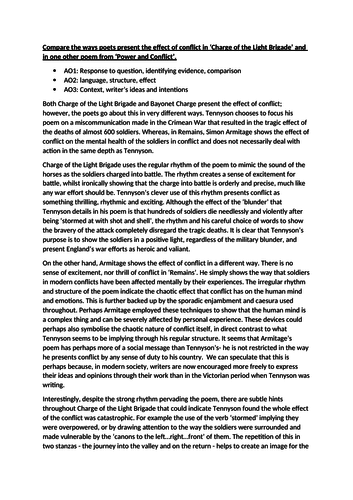
Grade 7/8 exemplar poetry comparison for AQA Literature Paper 2- effect of conflict
Subject: English
Age range: 16+
Resource type: Other
Last updated
28 October 2018
- Share through email
- Share through twitter
- Share through linkedin
- Share through facebook
- Share through pinterest

A comparison essay comparing ‘Remains’ and ‘Charge of the Light Brigade’ and how both poets present the effect of conflict. Meets all AOs for the Literature mark scheme. Roughly grade 7+ comparison.
Tes paid licence How can I reuse this?
Your rating is required to reflect your happiness.
It's good to leave some feedback.
Something went wrong, please try again later.
This resource hasn't been reviewed yet
To ensure quality for our reviews, only customers who have purchased this resource can review it
Report this resource to let us know if it violates our terms and conditions. Our customer service team will review your report and will be in touch.
Not quite what you were looking for? Search by keyword to find the right resource:
Comparing poems - AQA Compare the effect of form, structure and language
How do you tackle a poetry exam question that asks you to compare one poem with another? Learn about effective ways to explore similarities and differences to enable a better comparative response.
Part of English Literature Writing and analysing poetry
Comparing the effect of form, structure and language


IMAGES
VIDEO
COMMENTS
Below you will find a full-mark, Level 6 model answer for a poetry anthology comparison essay. The commentary below each section of the essay illustrates how and why it would be awarded Level 6. Despite the fact it is an answer to a specific Power and Conflict question, the commentary below is relevant to any poetry anthology question.
However in structure B, the comparison takes place throughout the whole essay and avoids looking at the poems separately. This is a better model to use and one which can be applied to comparisons ...
For today I have penned an example comparative paragraph on how POWER is depicted in 'Ozymandias' and 'My Last Duchess'. The first two sentences acts as my introduction and 'concept' (the BIG IDEA) that all of my paragraphs should refer back to: Both 'Ozymandias'' and 'My Last Duchess' depict power as being abused by ...
Compare how poets present the effects of war in 'Bayonet Charge' and in one other poem from 'Power and conflict'. ... (AQA) poetry essay compares 'War Photographer' and 'Remains'. This GCSE poetry essay is based upon the AQA English Literature exam format. ... For example, in 'Remains', the repetition of "probably armed, possibly ...
Here is an example of the AQA mark scheme for the last unseen poetry question. This question assesses AO2 only which requires you to analyse the language, form and structure used by the poets to create meanings and effects, using relevant subject terminology where appropriate. In addition, you are also required to identify the similarities and/or differences between the two unseen poems.
Overview. You can discover a lot about a poem by comparing it to one by another poet that deals with a similar subject or has a similar. theme. . Thinking about two poems and identifying where ...
Comparing Poems. After studying this section you should be able to understand: As part of the GCSE English Literature course, one of the things you will need to do is to 'explore relationships and comparisons between text, selecting and evaluating relevant material '. One of the ways in which you might be asked to do this is to compare two ...
Responding to poetry - AQA Essay plan. Responding to poetry - AQA. Writing your response to a poem, or making comparisons between two poems, takes careful planning. These tips show you how to ...
Unseen Poem Comparison Paragraphs No Intro. Go straight in exploring how both poems compare. Complete 2 paragraphs: Paragraph 1: Compare what -how -why in relation to poem 1 and 2 offering detail about how they are similar or different. Use as much evidence and terminology/methods as you can to explore the comparison Exploring the poem: What?
Learn some of these brilliant strategies for teaching really effective poetry comparison for GCSE English Literature, Paper 2, Section B.One of the elements of our students' exam performance we identified as a weakness in last summer's examination series was comparing poems from the AQA poetry anthology, Poems Past and Present, which forms part of GCSE…
Question paper (Modified A4 18pt): Paper 2 Shakespeare and unseen poetry - June 2022. Published 14 Jul 2023 | PDF | 204 KB. Mark scheme: Paper 1P Poetry anthology - June 2022. Published 14 Jul 2023 | PDF | 243 KB. Question paper: Paper 1N The 19th-century novel - June 2022.
The table below demonstrates some examples for how you might approach comparing the contexts between two poems. Both war poems: Owen - WW1; Armitage - contemporary Middle East conflict. Both show ...
Give your opinion about the poem. Have a sharp focus on the writer's purpose. Q4. Topic sentences should... outline arguments of each paragraph. include contextual detail. include key question vocabulary. Q5. It is useful to consider the similarities between poems and then consider on any subtle between them.
Instructions. Use black ink or black ball-point pen. Do not use pencil. Write the information required on the front of your answer book. The Paper Reference is 8702/2. Answer one question from Section A, one question from Section B and both questions in. Section C. You must not use a dictionary.
A comparison essay comparing 'Remains' and 'Charge of the Light Brigade' and how both poets present the effect of conflict. Meets all AOs for the Literature mark sch ... Grade 7/8 exemplar poetry comparison for AQA Literature Paper 2- effect of conflict. Subject: English. Age range: 16+ Resource type: Other. English teacher's shop. 4.28 ...
Compare the ways relationships with parents are presented in Mother, Any Distance and one other poem. Mother, any distance greater than a single span requires a second pair of hands. You come to help me measure windows, pelmets, doors, the acres of the walls, the prairies of the floors. You at the zero-end, me with the spool of tape, recording
GCSE; AQA; Comparing poems - AQA Compare the effect of form, structure and language. How do you tackle a poetry exam question that asks you to compare one poem with another? Learn about effective ...
A thematic comparison table of all 15 poems; Top tips for the highest grade; This should help you identify which poem you should compare a given poem to in your exam question, and help you create an effective thesis statement to answer the poetry question. Love and Relationship Poems. Here is a list of all the poems in the Love and ...
This guide is designed to support your teaching of poetry, specifically in preparation for the unseen poetry part of the exam. However, these activities and strategies can also be adapted for teaching the poetry anthology and, potentially, other texts studied throughout the course. Before going any further, it is worth being reminded of the ...
AO5. The candidate engages thoroughly with the debate set up in the question in the focus on the suffering of male characters in these texts and in the discussion of different forms of suffering. Overall: Coherent and thorough: this response seems to fit the Band 4 descriptors. This resource is part of the Love through the ages resource package.